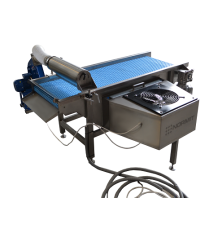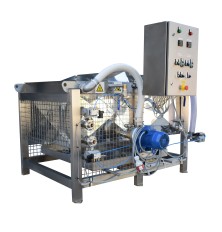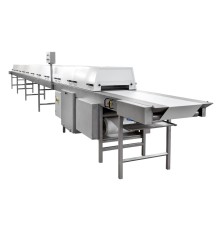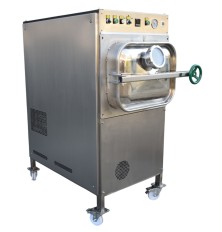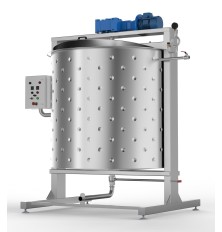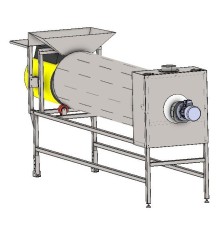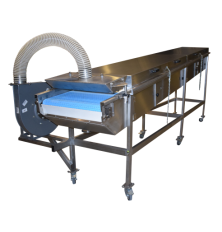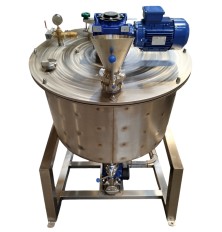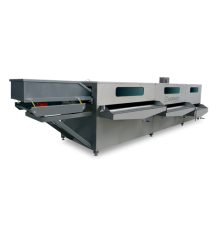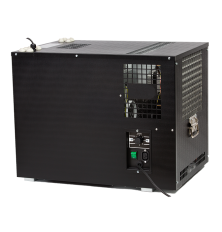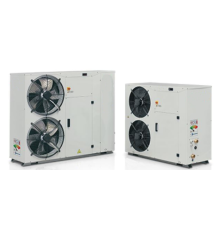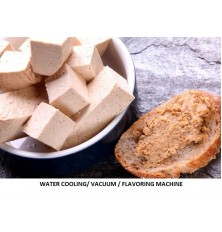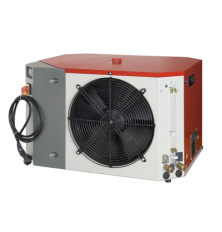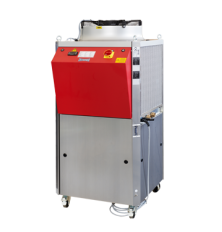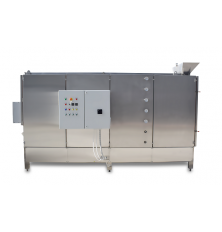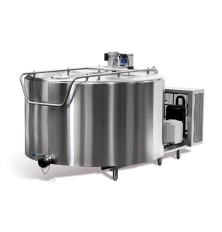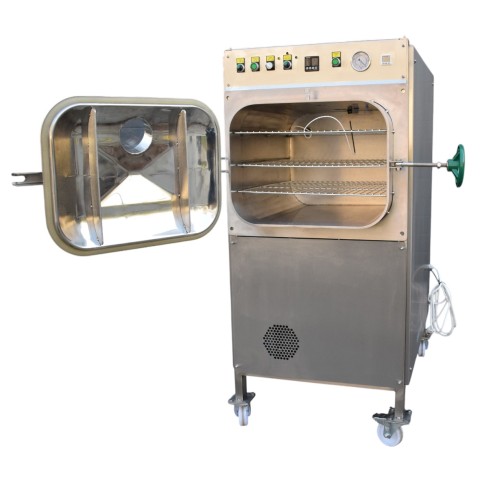






























Vacuum cooling lab for bread and pastries
The vacuum bread cooler is well-suited for application in small bakeries or as a laboratory unit in industrial enterprises. This enables the post-baking of bread under vacuum conditions, influencing both its shape and structure.
- Built-in deep vacuum system
- Built-in vapor removal and condensation system
- Built-in refrigeration system
- The chamber is designed for 3 gastro containers size GN 1/1, or pallets: 400x600/530x325 mm
- Compact and mobile installation
Vacuum cooling is quickly gaining popularity in food production, particularly in the baking of bread and pastries. This method significantly reduces baking time as the post-baking process occurs within the vacuum cooling chamber. Besides saving energy, vacuum cooling minimizes the space and time required for bread to cool before vacuum packaging, consequently lowering the risk of potential contamination.
Suitable for cooling various types of baked goods: rolls, croissants, baguettes and other types of bread.
Advantages of vacuum cooling bakery products:
- Cooling time is significantly reduced
- Baking time is reduced, which entails lower energy costs and increased productivity
- Extends product shelf life
- The product acquires an attractive appearance, the bread becomes voluminous and airy
- Does not require such a large area, as with the convective cooling method
Basic version
The vacuum cooler consists of a working chamber mounted on a wheeled support, featuring a hatch positioned at the upper part. This hatch includes an inspection window with lighting and a scraper for cleaning. Inside the chamber, there are guides designed for the placement of standard baking trays or gastro containers. The installation is equipped with a vacuum system, a condenser (with a vacuum depth: mBar - 20 (17¬įC)), a condensate collection tank and a chiller. The control includes a thermal controller with a temperature sensor to control the cooling temperature. ¬† ¬† ¬† ¬† ¬† ¬† ¬† ¬† ¬† ¬† ¬† ¬† ¬† ¬† ¬† ¬† ¬† ¬† ¬† ¬† ¬†¬†
Technical requirements
For proper operation of the unit, it is necessary to fill the chiller tank with water before the first start-up.
Principle of operation
Effortless and convenient control ensures the virtually automatic execution of all processes; once the product is loaded, the operator inserts the temperature sensor into the product, sets the temperature, closes the hatch, and initiates the process. Upon reaching the preset temperature in the product, the process automatically stops, the vacuum is released, and following a signal, the operator can open the hatch and retrieve the product.
The baking process of the product continues within the vacuum cooler at a pressure below atmospheric, allowing for a reduction in the boiling point of water inside the product. As secondary steam evaporates from the product under vacuum conditions, it also undergoes cooling. Meanwhile, the gelatinization process in the product remains uninterrupted. Following the operation of the installation, it will be necessary to release the container for collecting condensate. It is recommended to connect it to the sewer.
- Material: Stainless steel
- Principle of operation: Batch mode
- Country of origin: Slovakia
- Volume: 130l
- Voltage: 380-400V
You might also like
An air cooling conveyor is a system that uses moving belts and airflow to cool down products as they are transported along the conveyor line.
For additional information or a price quote, send us a request.
- Material: Stainless steel
- Principle of operation: Continuous mode
- Working Area Width: 500 mm
The stated price does not include the steam generator
The unique sectional cooking kettle is intended for high-performance cooking/blanching/frying of a wide range of products with subsequent cooling to avoid damaging their structure. An essential part of this technology is the efficient cooling section, necessary for halting the cooking process after unloading. This function is also necessary when processing vegetables to the "aldente" state, when vegetables retain their structure and natural color after thermal treatment. This model provides heating by direct injection of purified steam into the heating section (steam generator - option).
- Suitable for cooking small-sized products
- Fast and intense heating due to direct steam injection
- Intensive hydro-stirring
- Automatic basket lifting system
- Material: Stainless steel
- Country of origin: Slovakia
- Volume: 2x250l/ 3x250l
- Voltage: 380-400V
- Working volume: 2x175l/ 3x175l
Cooling tunnel with a length of 15.2 meters. The standard design consists of 13 sections with removable top. For more information, send us a request.
- Material: Stainless steel
- Principle of operation: Continuous mode
- Working Area Width: 400 mm
Designed for "cold" vacuum drying of products sensitive to high temperatures, also suitable for liquid and viscous products.
It is intended for pre-cooling after cooking or frying vegetables and fruit, meat, fish and seafood and other products.
- Material: Stainless steel
- Principle of operation: Continuous mode
- Country of origin: Slovakia
- Working Area Width: 600 mm
ACM mixing tank is intended for efficient cooling, heating, tempering and storing of mayonnaise, sour cream, chocolate, oil and similar products after their production.
- Material: Stainless steel
- Principle of operation: Batch mode
Lowering the temperature and humidity protects the product even without chemical treatment. The device is also used for continuous air cooling after heat treatment.
- Material: Stainless steel
- Principle of operation: Continuous mode
- Country of origin: Slovakia
An air cooling conveyor is used to rapidly cool products in food processing industries by circulating cool air over them as they move along a conveyor belt. This efficient cooling process helps preserve product quality and reduce the time between processing stages, facilitating smoother production workflows.
- Material: Stainless steel
- Principle of operation: Continuous mode
- Country of origin: Slovakia
- Voltage: 380-400V
The vacuum crystallizer-cooler is specifically designed for sweetened condensed milk. Crystallization with cooling is one of the most important stages in the production of condensed milk according to GOST and is necessary before dosing and packing the finished product.
- After crystallization, condensed milk has a delicate structure with small crystals
- Condensed milk has a homogeneous shape and attractive consumer properties
- The shelf life of condensed milk is extended without changing the quality of the product
- Material: Stainless steel
- Principle of operation: Batch mode
- Country of origin: Slovakia
- Volume: 100l/ 300l
- Voltage: 380-400V
- Max vacuum: -0,8 Bar
Heating: electric and steam - combination
- Material: Stainless steel
- Principle of operation: Continuous mode
The AS series chillers belong to the top professional cooling devices for quick beverages' chilling in restaurants, cafes, catering industry facilities, and pubs. The chiller is suitable for cooling water, spark or soft drinks, beer, wine, strong alcohol drinks, and others.
- Principle of operation: Continuous mode
- Country of origin: EU
- Cooling performance l/h: 160 l/h / 200 l/h
The new line of TCAEY compact cooling units is suitable as a cooling source for industrial applications. It's a reliable chilling device for cooling different kinds of liquids. 
- Principle of operation: Continuous mode
- Country of origin: EU
The vacuum diffusion cooling unit is a multifunctional device not only for vegan processors.
- Material: Stainless steel
- Principle of operation: Batch mode
- Country of origin: Slovakia
Cooling tunnel with a length of 15.2 meters. The standard design consists of 13 sections with removable top. For more information, send us a request.
- Material: Stainless steel
- Principle of operation: Continuous mode
- Working Area Width: 400 mm
The IBC container insulation cover is designed for use in ice water stations with IBC containers to maintain the cold coolant at a set temperature.
- Allows you to reduce energy costs of the refrigeration machine - chiller
- Protects from short-term fluctuations in ambient temperature, reflects sunlight (up to 97%)
- The cover is easy to install, with valve holes are installed with hook-and-loop fasteners (Velcro)
- Type of the equipment: Optional equipment
The cooling units have a compact design. They are space-saving and easy to assemble. The chiller in standard version can work at water outlet temperatures from +10¬įC to +25¬įC.
For more information, send us an email to sales@normit.com 
- Volume: 18 l/ 30l
- Voltage: 220-230V
A chiller is a cooling machine that removes heat from a liquid through vapor compression and absorption in a cyclic manner.
- Principle of operation: Continuous mode
- Cooling performance l/h: 100 / 200 l/ 300
The water chiller CHWHE consists of a cooling unit in the upper part and a pump plus isolated water tank (made of stainless steel) in the lower section. We offer different capacities.
- Volume: 120 l/ 300l
- Voltage: 380-400V
This multi layer belt dryer with integrated cooling system works as a dryer and cooler in one installation.
- Material: Stainless steel
- Principle of operation: Continuous mode
Milk cooler tank designed for cooling milk and other dairy products. The tank is available in 13 different capacities, covering a range from 50 liters all the way up to 2,500 liters, capable of meeting the needs of all dairy & cheese production facilities. We offer 2 or 4 milking options. Prices are displayed for the milk cooling tank with 4 milking.
- Material: Stainless steel
- Principle of operation: Batch mode






















